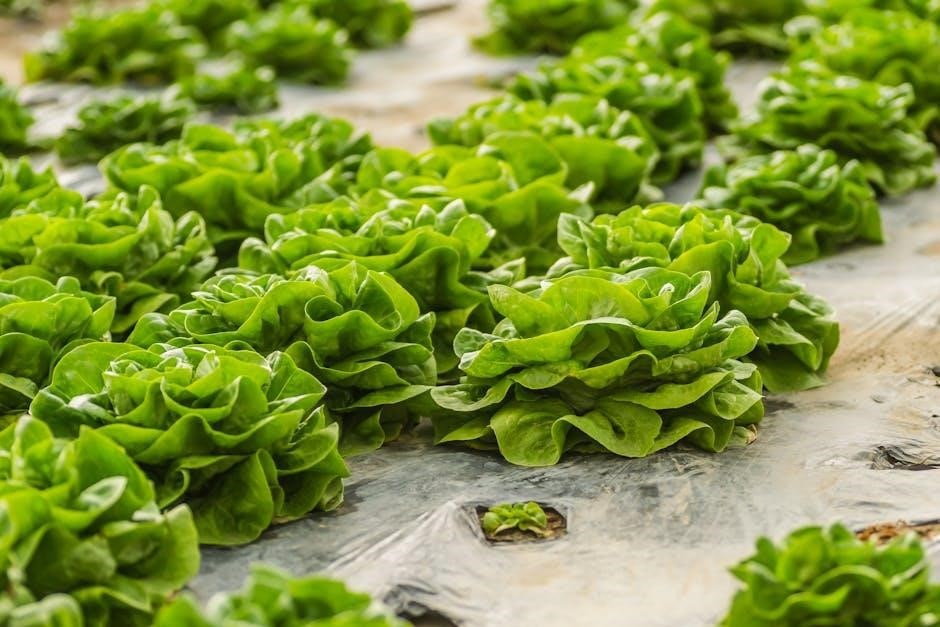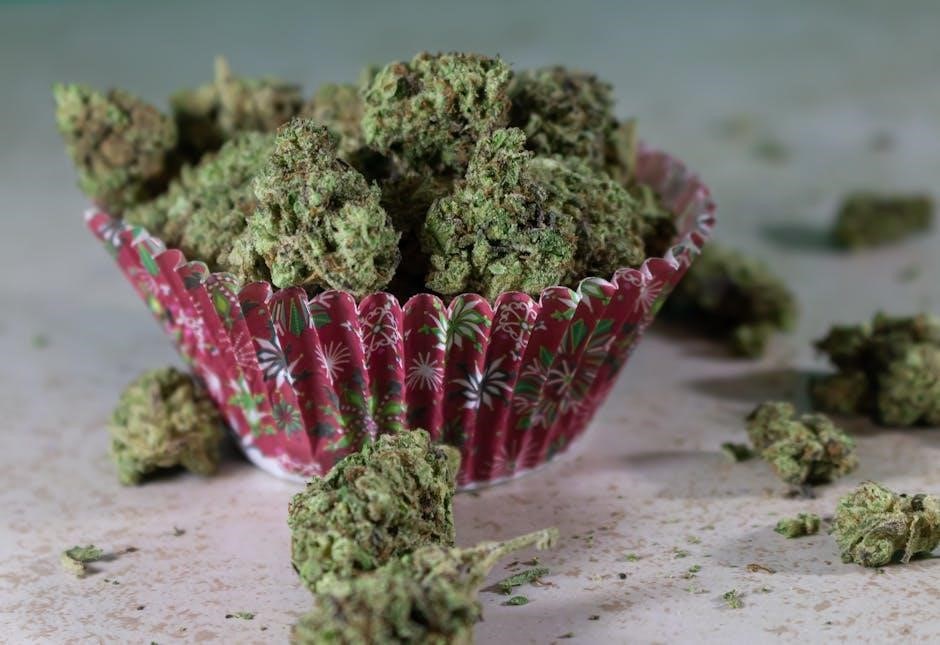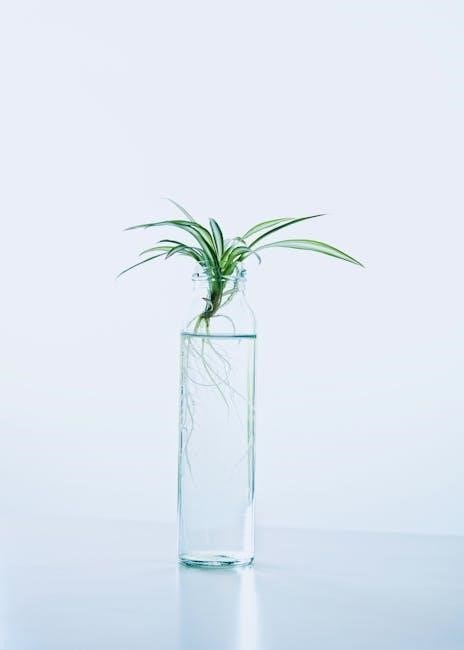Hydroponic marijuana growing is a soilless cultivation method using nutrient-rich water solutions, offering precise control over plant nutrition and environmental conditions for faster growth and higher yields.
Benefits of Hydroponic Growing Over Traditional Methods
Hydroponic growing offers numerous advantages over traditional soil-based methods. It allows for precise control over nutrient delivery, leading to faster growth rates and higher yields. Plants grow up to 20-30% quicker due to optimal nutrient absorption. Water efficiency is improved, as systems recirculate and reuse water. Space is maximized, enabling tighter plant spacing. Reduced soilborne diseases and better root oxygenation contribute to healthier plants. Overall, hydroponics provides a cleaner, more efficient way to cultivate cannabis with consistent, high-quality results.

Setting Up Your Hydroponic Grow Space
Select a clean, well-ventilated area with reliable power sources. Install essential equipment like DWC tanks, fans, and grow lights. Ensure proper temperature and humidity control for optimal growth.
Choosing the Right Location and Equipment
Selecting a clean, spacious indoor or greenhouse location with dedicated power sources is crucial for hydroponic marijuana growing. Ensure proper ventilation and temperature control by installing fans and carbon filters. Choose a hydroponic system like DWC tanks or drip irrigation, and invest in high-quality grow lights suitable for cannabis. A pH meter is essential for monitoring water conditions. Consider the space required for your plants and equipment to optimize growth and maintain a consistent environment for healthy plant development.
Essential Equipment for Hydroponic Growing
The essential equipment for hydroponic marijuana growing includes a hydroponic system (e.g., DWC or drip irrigation), grow lights, fans, and carbon filters for ventilation. A pH meter is crucial for monitoring water conditions, and a reservoir or tank is needed to hold the nutrient solution. Pumps and tubing are required to circulate the solution, while clay pebbles or another growth medium supports root development. Ensure all equipment is high-quality to maintain optimal growing conditions and promote healthy plant growth.
Understanding Hydroponic Systems for Cannabis
Hydroponic systems for cannabis are methods that deliver nutrients directly to plant roots, eliminating the need for soil. This enhances growth and increases yield significantly.
Types of Hydroponic Systems (DWC, NFT, Ebb and Flow)
Hydroponic systems for cannabis include Deep Water Culture (DWC), Nutrient Film Technique (NFT), and Ebb and Flow. DWC involves plants in buckets with roots suspended in nutrient-rich water. NFT uses long channels where roots receive continuous water flow. Ebb and Flow periodically floods the grow area with nutrients. Each system offers distinct advantages, such as improved oxygenation in DWC, space efficiency in NFT, and adaptability in Ebb and Flow, making them popular choices for hydroponic growers.
Pros and Cons of Each Hydroponic System
Each hydroponic system has unique advantages and drawbacks. DWC offers high oxygenation and simplicity but requires frequent water changes; NFT provides excellent root oxygenation and space efficiency but can be complex to set up. Ebb and Flow is versatile and water-efficient but may have higher initial costs. Understanding these pros and cons helps growers choose the best system for their setup and experience level, optimizing growth and yield for cannabis cultivation.
Nutrient Management in Hydroponic Cannabis Growing
Nutrient management is crucial for hydroponic cannabis, requiring precise control of NPK levels and micronutrients. Regular monitoring ensures optimal absorption, preventing deficiencies and nutrient burn.
Optimal pH Levels for Hydroponic Plants
Maintaining the optimal pH level is critical for hydroponic cannabis plants, as it directly affects nutrient absorption. The ideal pH range for hydroponic plants is between 5.5 and 6.5, with 6.0 being the sweet spot for most strains. Consistency is key, as fluctuations can cause nutrient deficiencies. Regularly test and adjust the pH using a high-quality pH meter to ensure your plants absorb essential nutrients efficiently. Automated pH control systems can also help maintain stability and prevent growth hindering imbalances.
Best Nutrients for Hydroponic Cannabis
The best nutrients for hydroponic cannabis are balanced fertilizers with essential macronutrients (N, P, K) and micronutrients (Ca, Mg, Fe). A balanced NPK ratio, such as 20-20-20, is ideal for vegetative growth, while blooming phases benefit from higher phosphorus levels. Organic options like fish emulsion and compost tea are popular for their natural benefits. Avoid over-fertilization, as this can cause nutrient burn. Proper dilution and pH adjustment are crucial for optimal nutrient absorption and plant health in hydroponic systems.

Lighting Requirements for Hydroponic Cannabis
Lighting is crucial for hydroponic cannabis, requiring high-intensity grow lights with adjustable spectrum and duration to optimize photosynthesis, plant health, and yield throughout growth stages.
Choosing the Right Grow Lights
Selecting the right grow lights is critical for hydroponic cannabis growth. LED grow lights are popular for their energy efficiency and adjustable spectrum. HPS (High-Pressure Sodium) lights are effective for flowering, while CFLs are suitable for smaller setups. Consider the wattage and coverage area to ensure proper light distribution. Energy-efficient options with dimming capabilities can optimize plant growth and reduce heat. Always choose lights with adjustable spectrums to match different growth stages, ensuring maximum photosynthesis and healthy plant development.
Lighting Schedules for Different Growth Stages
Lighting schedules are crucial for hydroponic cannabis growth. Seedlings require 18-20 hours of light to promote healthy root development. During the vegetative stage, increase to 18-24 hours to encourage leaf growth. In the flowering stage, reduce to 12 hours of light and 12 hours of darkness to trigger bud production. Consistency is key to avoid stressing plants. Adjust schedules based on strain requirements and environmental conditions for optimal results and maximized yield.

Plant Care and Maintenance
Regular monitoring of your hydroponic system is essential to ensure healthy plant growth. Maintain consistent conditions, sanitize equipment, and prune plants to optimize growth and prevent disease.
Germination and Seedling Care
Germination in hydroponics begins with high-quality seeds placed in a moist, controlled environment. Maintain consistent moisture and warmth for 1-2 weeks until roots develop. Once germinated, seedlings require careful handling to avoid stress. Provide low-intensity lighting and maintain optimal pH levels for root health. Monitor seedlings closely, ensuring proper water circulation and nutrients. Avoid over-handling to prevent shock, and transplant to the hydroponic system only when roots are well-established. Proper care during this stage sets the foundation for healthy growth and robust yields.
Pruning and Training Techniques
Pruning and training are essential for promoting healthy growth and maximizing yield in hydroponic marijuana cultivation. Regular pruning removes dead or damaged leaves, improving airflow and light penetration. Techniques like topping or using trellises help control plant shape and optimize space. Prune during the vegetative stage to encourage bushy growth, and train plants to align with hydroponic system requirements. Proper pruning and training enhance nutrient distribution, light absorption, and overall plant health, leading to robust bud production and a successful harvest.

Monitoring and Automation in Hydroponic Growing
Regularly monitor pH, nutrient levels, and temperature to ensure optimal growing conditions. Automation tools like timers and sensors streamline tasks, reducing manual labor and potential errors. Consistent conditions enhance plant health and yield, making automation a valuable asset for modern hydroponic growers.
Regular Monitoring of Nutrient Levels and pH
Regular monitoring of nutrient levels and pH is crucial for hydroponic marijuana growing. Aim for a slightly acidic pH (5.8–6.2) to ensure optimal nutrient absorption. Check nutrient levels daily using a TDS/EC meter and adjust as needed. Overfeeding can cause nutrient burn, while underfeeding may lead to deficiencies. Maintain consistency to promote healthy plant growth and maximize yields. Regular testing prevents imbalances, ensuring plants thrive in their hydroponic environment.
Automation Tools for Hydroponic Systems
Automation tools are essential for streamlining hydroponic marijuana cultivation. Devices like automated pH controllers, nutrient dosers, and environmental control systems ensure consistent growing conditions. These tools monitor and adjust pH levels, nutrient delivery, and temperature, reducing manual labor. Smart systems can even alert growers to potential issues via mobile apps. Automation enhances precision, improves efficiency, and maximizes yields, making it a valuable investment for both novice and experienced hydroponic growers.

Common Challenges and Solutions
Hydroponic marijuana growing often faces challenges like nutrient deficiencies, pH fluctuations, and root rot. Regular monitoring, proper sanitation, and maintaining balanced nutrient levels are key solutions.
Pests and Diseases in Hydroponic Systems
Hydroponic marijuana systems are prone to pests like spider mites, aphids, and root rot due to high humidity. Regular sanitation, biological controls, and proper ventilation are essential. Inspect plants daily for signs of infestation or disease. Use neem oil or insecticidal soap for treatment. Maintain clean equipment and avoid overwatering to prevent root rot. Introduce beneficial insects like ladybugs to control pests naturally. Monitor pH and nutrient levels to avoid stress, which makes plants more vulnerable to disease. Act quickly to prevent outbreaks and protect your crop.
Troubleshooting Nutrient Deficiencies and Burn
Nutrient deficiencies and burn are common issues in hydroponic systems. Identify deficiencies by yellowing leaves (nitrogen) or discolored veins (iron/magnesium). Overfeeding causes leaf burn, with yellow or brown edges. Adjust pH levels to ensure nutrient availability and flush the system with clean water if overfed. Use balanced nutrients and monitor levels regularly. Early detection prevents severe damage, ensuring healthy plant growth and maximizing yield. Consistent monitoring and quick action are key to resolving these issues effectively.
Best Practices for Maximizing Yield
Maintain consistent growing conditions, optimize nutrient levels, and ensure proper sanitation. Use plant training techniques like topping or LST to maximize bud production and airflow, enhancing overall yield.
Consistent Growing Conditions
Maintaining consistent growing conditions is crucial for hydroponic marijuana success. Ensure stable temperatures (70-85°F during the day, 58-70°F at night) and humidity levels (40-70%), adjusting as plants mature. Lighting schedules must be precise, with 18-24 hours for vegetative growth and 12 hours for flowering. Avoid sudden environmental changes, as they can stress plants, leading to issues like nutrient burn or stunted growth. Consistency ensures optimal nutrient absorption and promotes healthy, robust plant development throughout the grow cycle.
Sanitation and Cleanliness in the Grow Space
Maintaining a clean and sanitized grow space is essential for hydroponic marijuana cultivation. Regularly disinfect all equipment, surfaces, and tools to prevent contamination. Use protective gear like gloves and masks to minimize human transfer of pathogens. Ensure proper air filtration with carbon filters to remove impurities and odors. Monitor for pests and mold, addressing issues promptly to avoid widespread contamination. A clean environment promotes healthy plant growth and prevents costly setbacks, ensuring a successful harvest.
Hydroponic marijuana growing offers precision, efficiency, and higher yields. Maintain optimal pH, monitor nutrients, and ensure sanitation for thriving plants. Expert tips and consistency guarantee success in your hydroponic journey.
Summarizing Key Points for Success
Hydroponic marijuana growing requires precise control over nutrients, pH, and environmental conditions. Regular monitoring ensures optimal plant health, while sanitation prevents pests and diseases. Consistency in lighting, temperature, and nutrient delivery maximizes yields. Starting with high-quality seeds and maintaining proper ventilation are critical. Automation tools can streamline the process, but manual checks are essential. By following these guidelines and adapting to plant needs, growers can achieve successful, high-yielding hydroponic cannabis crops consistently.